“It was a magnificently imaginative invention, a form of odyssey in which the lonely heroism of unpaced riders was pitted against relentless competition and elemantal nature. The Tour encompassed the territory of France, and Desgrange later claimed that it encouraged a sense of national identity, establishing La Patrie in clear geographic terms.”
– Jim McGurn on the Tour de France
The Tour de France is one of the biggest sporting spectacles in the world. In terms of spectators getting to see the event live, it has no parallel – with millions lining the roads of France and Europe throughout the month of July.
Stats of the Tour de France
In 2013 – a caravan of 4,500 people including organisers – teams – media – partners – publicity caravan – providers made up the tour. This excludes many volunteers and local council workers who help to get the tour ready.
Riders
- 198 riders at the start (22 teams of 9 riders) 2014)
- 300 support staff
Route for 2014
- 3,664 km (21 stages)
- 4 countries visited (the United Kingdom, France, Belgium, Spain)
- 33 French departments visited
- 36 stage towns/cities
Internet popularity
- 30 million unique visitors / 110 million pages viewed on letour.fr in 2013
- Most popular languages for viewing letour.fr: French, German, Spanish and English (the most visited version)
Spectators by the side of the road
- An estimated 12 million spectators (2013)
- 63% of men and 37% of women
- Average time by road side – 6 and a half hours of presence on average on the road-side.
Media coverage
- Broadcast in 190 countries (2013)
- Almost 100 channels including 60 live broadcasters
- 90 hours of live programmes (broadcast internationally)
- 5,500 hours of broadcasting throughout the world
- 3.5 billion viewers worldwide (in 2013)
Le Tour de France in Yorkshire 2014
An estimated 2.5 – 4 million fans lined the roads to see the Tour de France cover two stages in Yorkshire.
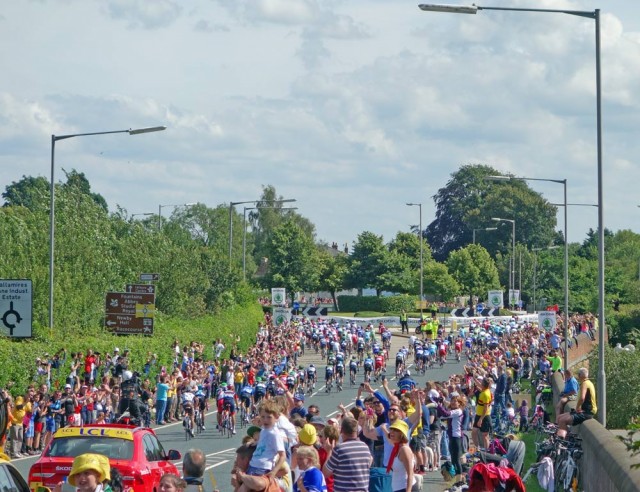
“I can see the Tour in their hearts, and in their eyes. For that, I say thank you to everyone in Yorkshire who has made this Grand Depart so very, very special.”
Christian Prudhomme
How Long is the Tour?
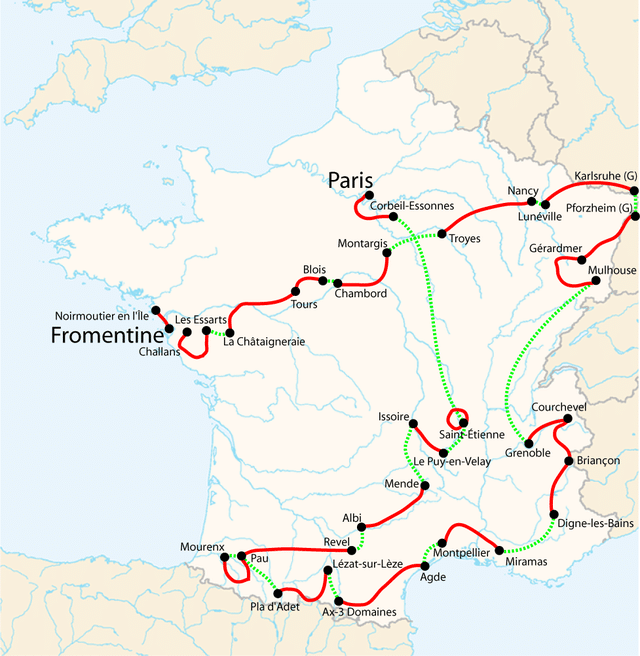
Modern versions are roughly about 3,600 kilometres (2,200 miles) spread out over three weeks. Early Tours were longer. In 1926, riders had to cover 5,745 km over 17 stages.
The longest ever stage in the Tour de France was on 7th July 1919 – 482 km (300 miles) won by Jean Alavoine from Les Sables-d’Olonne to Bayonne.
Average speed in the Tour de France?
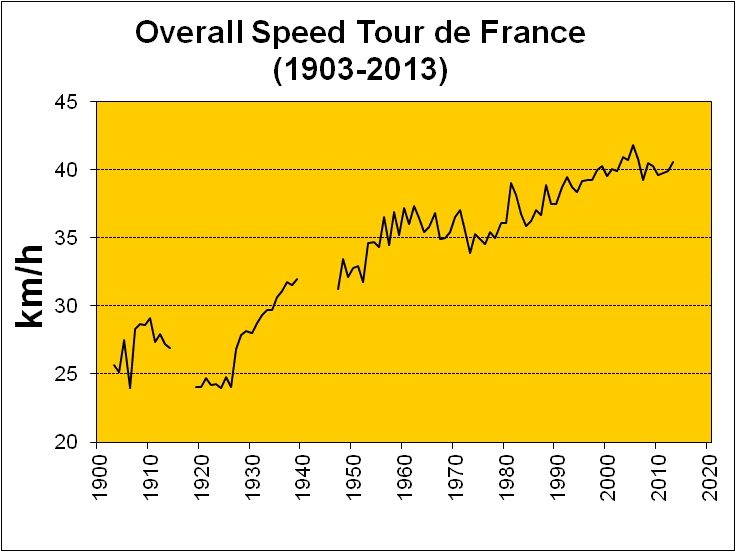
In 1926, the tour winner averaged 24 km/h over the whole 5,745 km. By comparison in 2010, the average speed was just under 40 km/h for the 3,642 km.
The slowest average speed was in 1919, when French roads were in a bad state after the First World War. The winner Firmin Lambot (Bel) completed the course at an average speed of 24.056 km/h
What Does the Yellow Jersey Mean?
The yellow jersey is worn by rider at the top of the overall classification. (the quickest time over the combined stages so far).

The yellow jersey was introduced in 1919 several years after the Tour started. It was chosen it was felt the yellow jersey would help identify the leader to spectators on the road. Yellow was chosen because the newspaper L’Equipe which sponsored the Tour was printed on yellow paper. The first yellow jersey wearer was Eugène Christophe in 1919. (see: birth of yellow jersey) Some riders said they were offered a yellow jersey in previous years but they didn’t want to wear it.
Can you win the Tour de France without winning a stage?
Yes, it has happened 6 times. Recent winners of the Tour who didn’t win a stage include:
- Gred Lemond 1990 and
- Oscar Pereiro (2006)
The only rider to win the first and last Tour de France that they entered was Fausto Coppi (ITA)
What is the King of the Mountains Competition?

A separate competition within the Tour. Riders are given points for being the highest placed rider over the summit of mountains. The best climber was first recognised in 1933, and the distinctive white and red polka jot jersey was introduced in 1975 to show person with most points in the King of the Mountains.
For example, on the most difficult climb (hors category) e.g. Alpe d’Huez a rider is given 20 points for being 1st and 16 points for being second. For smaller and easier climbs less points are available.
What is the Green Jersey for?
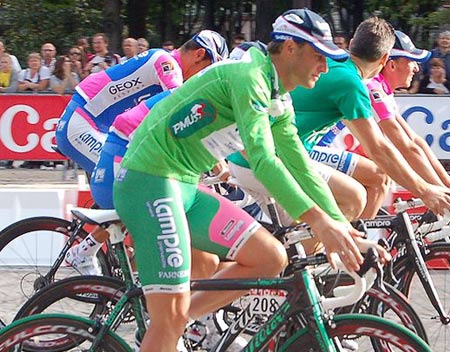
The Green jersey is awarded for the leader of points competition. Points are awarded for placings in stages. e.g. in a flat stage finish 1st place gets 45 points, second place gets 35. You can also pick up points during intermediary sprints during a stage. The green jersey ignores overall time and just the number of points you pick up at end of stages. It tends to favour sprinters because they tend to finish high up in the majority of stages. However, the wearer of the Green jersey needs to be consistent and pick up points on many stages. To win the green jersey you have to make it over all the mountain stages and finish in Paris. Some sprinters like Mario Cippolini won many sprints, but would retire in mountain stages. In recent years, the competition has been dominated by Peter Sagan – not the fastest sprinter, but a good all round finisher.
The competition was introduced in 1953 to celebrate the 50th anniversary of the Tour de France.
What is the White Jersey for?
The white jersey is for the young rider (under 26) who has the highest placing on overall classification. It was introduced in 1975 (though excluded not run during ’89 to ’99) Winners of the white jersey who went onto win overall include:
- Laurent Fignon 1983 (FRA) (also won overall that year)
- Greg LeMond 1983 (USA)
- Marco Pantani 1994, 1995 (ITA)
- Jan Ullrich 1996 (GER)
- Alberto Contador 2007 (ESP) (also won overall that year)
Combativity Prize
Introduced in 1952, the combativity award is given to the rider on the stage who is considered by a jury to be the most attacking and aggressive racing. This tends to reward riders who get into a break for the longest time period. The winner of the day is awarded € 2000. For the next stage, the rider is given a white number on a red background. At the end of the Tour, a rider is awarded the “super-combativity award” for most aggressive rider of the tour.
Why do the riders spend most of the time in the Peleton (big bunch?)
Riding behind another rider saves unto 25-30% of your energy. In some cases, right in the middle, it is estimated you can save up to 50%. If you ride ahead of bunch you will need much more energy. Therefore it is very difficult to ride off on your own away from the bunch. However, some riders will try to win the stage and get into a break ‘a group of a few riders’ trying to get to finish before peleton.
How many minutes behind the leader does it take to be eliminated from the tour de France?
Riders have to finish within a certain time period behind the winner of the stage. This is roughly 20% extra time. But, it depends on the difficulty of the stage. For a difficult mountain stage, the cut off is worked out by:
- Up to 18 percent if the average speed of the winner is greater than 24 mph (38kmh)
For example, if there was a 200km stage won by the first rider in 5 hours (average speed 24.85mph), then the cut off would be an extra 54 minutes (18% of 300 minutes)
What is the Autobus?
Riders have to finish within a certain time frame, otherwise they get eliminated. This is calculated by a % slower than winners time (see above) On tough mountainous stages, riders may join together to try and make sure they are not eliminated. The autobus is usually the last big group on the road. Also by being in a big autobus, riders hope that on really hard stages, even if they finish outside the time limit the Tour organisers won’t dare eliminate half the field.
If more than 20% of riders fail to make the time limit, the organisers can review the time and decide to give them more time.
Why don’t they do every stage as a Time Trial?
A time trial or contre-la-montre, (“against the clock”, or literally against the watch) means riders rely solely on their own efforts. There is no chance of race tactics or hiding in bunch. Arguably, this is truer sporting test as the strongest rider wins. However, it is not the most spectator friendly event. The race tactics and speed of bunch sprint is much more exciting than repeated time trials. Therefore, they are usually limited to one or two.
What is a Domestique?
Most riders in the tour have no chance or expectations of winning. Therefore they act as ‘servants’ or ‘support riders’ for their team leader. They will drop back to pick up water bottles ‘bidons’ from their team car and then bring them back to their leader. If a break needs chasing down, ‘domestiques’ will work on the front enabling the team leader to save his energy for later. In some circumstances they will be expected to give up their wheel or even their bike to save their leader time. It is hard to win the Tour without a very committed team of domestiques willing to sacrifice themselves for their team leader. It is said Lance Armstrong’s dominance was built around a team with unflinching loyalty (though that loyalty didn’t extend to belated doping allegations).
Also, there are domestiques and there are super-domestiques. It sometimes happens that the domestique turns out to be stronger than the team leader (Hinault and LeMond in 1985). Froome v Wiggins 2012. This can be embarrassing all round. The moment of greatest interest in the 2012 tour was when the loyal Froome – dog wanted to let go of his leash and started ‘attacking’ Wiggins. Wiggins was said to be in near tears at the end. Though in the time trials, Wiggins was able to dish out his power and show Froome who was the boss.
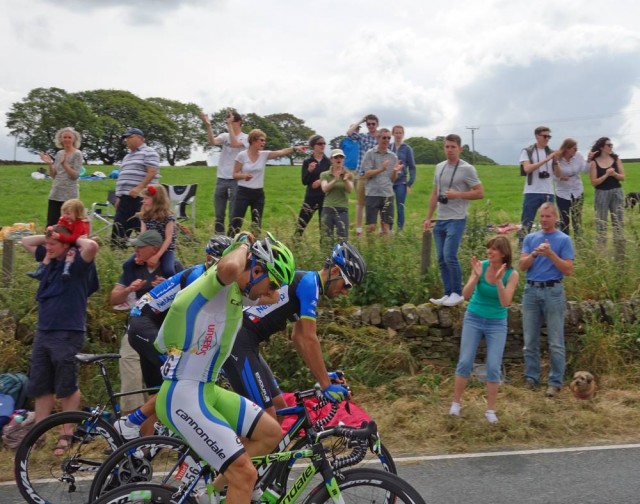
In Italy, the domestiques are called Gregarios because ‘Gregarios’ sounds better and importantly it sounds less French. (see also cycling terms explained)
What is an Echelon?
Usually, you want to ride behind another rider to save energy. However, in a very strong side wind you want to ride by their side. Therefore in a strong side wind, everyone tries to ride to the side of another, leading to these diagonal looking ‘echelons’. This can be dangerous for leading contenders because the peleton is split up into different groups and they can drift away from main pack.
Are you allowed to cover part of the course on foot?
2016 stage to Mont Ventoux was very crowded because the finish was moved 6km downhill due to high winds.
Froome crashed and his bike was run over by motorbike, with no spare, he started to run and covered a lot of ground
What is the Lantern Rouge?
The last rider overall on general classification. For a time the lantern rouge would carry a little red light under their saddle. It became paradoxically a cool thing to be. Lantern Rouge’s would gain more fame than person second to last. For a few years in the 1940s, organisers experimented with sending the last rider (lantern rouge) home to try and discourage this unofficial competition to be the lantern rouge.
Even now some riders really don’t mind being lantern rouge as they are domestiques and it means at least they are still in the race. There can even be a little light competition to get lantern rouge.
Kenny Van Hummel gained fame after being lantern rouge by a huge margin during 1999 tour (cycling news)
As David Duffield once said:
De las Cuevas is so far down on GC you could time him in with a calendar!
Prize money in the Tour de France
In 2014, a total of around 2 million Euros will be awarded and given out to the teams and the riders, including 450 000 Euros to the winner of the final individual general classification [1]. However, bear in mind the winner’s prize money is split throughout the team, including 8 other riders, plus all the backroom support staff. This compares to an event like Wimbledon, where the winner of the men’s and women’s singles can pick up £1,760,000
Why is Mark Cavendish not in the lead despite winning so many stages?
The overall leader of the Tour is based on time. In many stages that Mark Cavendish wins, he gets the same time as all the other riders. He is just the fastest sprinter. However, in mountain stages, he may finish 30 minutes behind the leader of the tour because although good at sprinting he doesn’t have a good build for climbing. The winner of the tour will have to be good at time trials and climbing.
Why does Mark Cavendish not Get the Green Jersey despite winning the most stages.
In 2009, Mark Cavendish won 6 stages but still didn’t win Green jersey. This is because the Green jersey competition rewards most consistent finisher. You can win Green jersey just by finishing high up in stages and sprinting for intermediate stages. He would probably have won green jersey if he hadn’t been disqualified during one sprint, which saw him relegated to back of bunch
Can you Win the Tour De France Without Winning A Stage?
Yes, this has happened 6 times, including Alberto Contador in 2010. The overall is just the fastest time.
GC contenders
GC stands for General Classification (top overall). There may be about 5-10 riders in with a chance of the general classification (and getting to wear the yellow jersey).
Does riding the Tour take years off your life?
According to this study. Tour de France riders live longer.
We observed a significant 41% lower mortality among French elite cyclists from the Tour de France, compared with the general male population.
What is a race within a race?
Sometimes, in a stage, there may be a breakaway of riders who are long way down the GC. They have no chance of getting into the yellow jersey, but they could win the individual stage. Therefore, there is one race for the day’s stage, but also the wider battle for the overall. The big GC contenders won’t mind too much if someone 40 minutes down on overall goes on a breakaway because it doesn’t threaten their overall position.
How come the Tour de France is starting in Yorkshire?

Apart from the fact that Yorkshire is ‘God’s own county’, the Tour de France often starts outside France (usually every other year). This is partly in the spirit of pan-European friendship to share the world’s biggest stage race with neighbouring European countries. It is also because towns and regions will pay the organisers a lot of money to get the ‘privilege’ of hosting a few stages. The Tour de France will be an opportunity for a global audience of 1 billion people to see the breathtaking beauty of Yorkshire. The Tour is basically a three week advertising fest.
Who was the Greatest Tour de France rider of all time?
Cue endless debate on cycling forums. You can really take your pick from any of the riders who won more than five times
- Jacques Anquetil in 1957, 1961, 1962, 1963 and 1964;
- Eddy Merckx in 1969, 1970, 1971, 1972 and 1974;
- Bernard Hinault in 1978, 1979, 1981, 1982 and 1985;
- Miguel Indurain in 1991, 1992, 1993, 1994 and 1995 (the first to do so in five consecutive years).
In terms of number of victories Lance Armstrong (7) stands out 1999-2006. Though there is now a rather embarrassing line through his name, after they were all stripped away due to drug use. To say Lance Armstrong completely dominated the Tour de France for a decade, his name is now only mentioned in hushed tones, as people quickly move onto other topics, like what a great rider Marco Pantani was.
How many winner in the past 20 years can you believe won the tour ridding clean?
Of winners in the past generation, David Walsh said he only had faith in Bradley Wiggins, Chris Froome Cadel Evans, and Greg LeMond. I would agree with that. Perhaps also Carlos Sastre, I don’t know.
Who was the least well known rider to win the Tour?
In modern times Óscar Pereiro was undoubtedly a surprise in 2006. He befitted from Floyd Landis’ disqualification. His only other major win was a stage in the Tour of Switzerland, and 10th overall in the Tour de France in 2005 and 2004. He is now playing football for Coruxo FC of the Segunda División B in Spain. Making him the best qualified football player to have the distinction of winning the Tour de France.
Who was the Greatest Tour de France rider never to win?
Perhaps an easier one to answer. Most people would give Raymond Poulidor or ‘Pou Pou’. His nickname was also the ‘eternal second’ Despite an 18 year old career which involved winning 189 races he could never win the Tour. He finished second or third a combination of eight times. Perhaps he just had the bad luck to be riding in same generation as Jacques Anquetil and Eddy Merckx. To make it even better he was an attacking rider, good in the mountains. In many ways we prefer a plucker loser to a ‘boring’ winner. ‘Pou Pou’ probably gained greater love than Jacques Anquetil or Miguel Indurain who ground out wins by dominating in time trials.
The closest Tour de France?
Everyone remembers the 1989 Tour. The American Greg Le Mond v the bespectacled Frenchmen, Laurent Fignon. On the last stage, a Time Trial on the Champs Elysees, Greg Le Mond managed to overturn a 50 second deficit and wins overall by a mere 8 seconds. Greg Le Mond made use of new technology – triathlon style time trial bars, leaving Laurent Fignon distraught at the side of the road.
Most Popular Towns for Stages?
- Paris – 135 (most recent finish: 2010) (has finished on Champs Elysees on every year since 1975
- Bordeaux 80 (most recent: 2010)
- Pau 62 (most recent: 2010)
The Most Scandalous Tour de France?
It would be a mistake to think that scandal and drug taking are a modern phenomenon of the Tour. On the early tours, riders were specifically told they had to bring their own stimulants. Early tours were full of intrigue like riders being disqualified for taking the train or riders facing roads full of tacks to give their rivals an advantage. It was only in the 1960s when drug testing came in, and even then it was sporadic and by all accounts quite easy to dodge.
However, for the sheer scale of scandal and upheaval it’s hard to forget the Festina Scandal of 1998.
During the tour, Willy Voet a soigneur for the French team Festina, was found with a car full of doping products. The Festina team were sent home, and amidst drug raids by the authorities on other teams, the riders began to protest on mass. Only half the field finally made it to Paris, where Marco Pantani’s win was overshadowed by the massive drug controversy. (Pantani himself was later to tragically die young from drug related problems) Though perhaps even Festina scandal was overshadowed by the downfall of Armstrong.
Don’t they all just dope – How can anyone ride the tour without?
Many non-cyclists ask this. But, you definitely can ride and people do ride the tour without taking any illegal stimulants. Yes, the tour is difficult but it is feasible for professional athletes. Doping products just enable you to ride it at a faster average speed. In the EPO era, times up the last mountains were particularly quick, with big ‘fat’ 80kg riders going up steep climbs ‘on the big ring’. This seems to be no longer the case.
Is the Tour cleaner than before?
It is subjective, but I would say it is cleaner and there is much less doping. I think there has been a big shift in attitudes. I tend to believe people unless there is convincing evidence otherwise. Though decades of doping and lying have unfortunately created a suspicious mind in many cycling followers.
Who has died whilst riding the Tour de France?
- Adolphe Heliére, France. Drowned while swimming during a rest day of the 1910 Tour de France.
- Francisco Cepeda, Spain, Tour de France, 1935. Died after crashing on the descent of the Galibier
- Tom Simpson, July 13, 1967 (combination of heat exhaustion, overuse of stimulants) amphetamines found in his back pocket)
- Fabio Casartelli, Italy, Tour de France, July 19, 1995. Casartelli was the reigning Olympic Champion at the time of his crash and subsequent death
Most Bizarre Regulations in the Tour?
In 1925 Herni Desgrange’s planned that riders should all eat exactly the same amount of food each day. Riders striked in protest and it was later dropped. Desgrange was famous for trying to make the Tour as hard as possible. He resisted allowing gears into the Tour for as long as possible. He said the perfect race would be one where only one rider was able to finish.
“I still feel that variable gears are only for people over forty-five. Isn’t it better to triumph by the strength of your muscles than by the artifice of a derailer? We are getting soft… As for me, give me a fixed gear!”
– Henri Desgrange
In early editions of the tour, riders had to do their own mechanical repairs. In 1913, Eugène Christophe was on course to win when his fork broke on a mountain descent. He went to local forge and tried to repair his fork himself. As well as losing time, he was also fined 3 minutes, because a 7 year old boy helped push the bellows.
What happens when a rider wants to answer a call of nature during a long six hour stage?
Sometimes riders stop at the side of the road and many others will join them. There is an unofficial rule not to attack when riders are answering a call of nature. Sometimes when racing is hotting up, riders will not stop but urinate on the move. A task not too easy. They are not allowed to do it in built up areas and preferably not when cameras are on. You can get fined by the commissar, if you answer a call of nature in an ‘inappropriate place’!
How Much Do they Eat during a stage?
A Tour de France rider may consume something in the region of 6,000-8,000 calories (daily recommended is 2,000). If you think it’s difficult to consume 8,000 calories try doing it on a vegan diet like D.Zabirskie (Independent)
When Are you Going To Ride the Tour de France?
Tell a non-cyclist I’ve won a local club time trial against a collection of other amateurs, and the next question is often – so when are you going to ride the Tour de France? It’s not quite like the London marathon where you can turn up with good intentions and promise to raise some money for charity. Only the top 20 pro teams will get invited to the Tour, and they will pick their best 9 riders. This means the field is limited to about 180 riders. Many great pro cyclists will not ride the Tour de France because they will concentrate on other great races in the calender like the Giro d’Italia or classics like Paris Roubaix.
What’s the Most Bizarre TV Commentary you heard whilst listening to the Tour de France?
Let’s be honest, the tour is mostly dull, only watching the breakaway time come slowly down. Fortunately, we have commentators like David Duffield who can manage to get excited by the most trivial of incidents.
“I am sitting here with my chin on the counter, my mouth open like a great big whale scooping up plankton. I am gobsmacked!”
“This is like Wimbledon., Ascot and Silverstone all wrapped in together and plonked in the middle of Paris: amazing!
Why is there always a devil raising a trident by side of road?
I’ve really have no-idea. You could always ask the devil himself but he seems to enjoy himself.
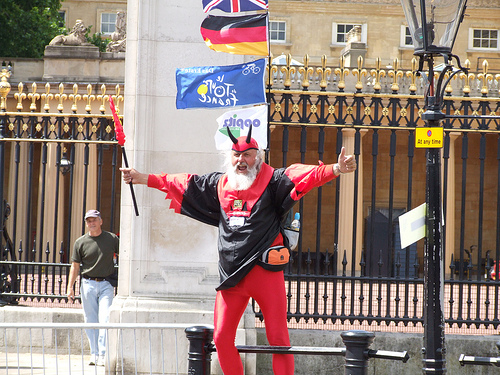
The Devil at the Tour de France – from Loving Photography
What happens to all the litter thrown by the riders?

After the stage, sweepers go and pick up any litter. Though now the Tour has designated areas for riders to throw their rubbish to try and reduce environmental impact of the tour.
Tour Glossary
- Bidon – bottle
- Combativité – Most aggressive rider, person who goes out on long breakaways
- Drafting – riding behind another rider to save aero drag
- Flamme rouge – Red kit showing 1Km to go
- Grand Départ – First Stage
- le parcours – route, course
- le peloton – The big bunch of riders on the tour
- l’équipe – team
- le coureur- rider
- le sprinteur – sprinter
- le grimpeur – climber
- la tête de course – race or course leader
- les domestiques – ‘servants’, riders who protect their leader
- l’étape – stage
- l’étape de plaine – flat stage
- l’étape de montagne – mountain, climbing stage
- l’étape contre la montre – Time Trial
- les classements – standings, rider positions after each stage
- le maillot jaune – yellow jersey – for the leader
- le maillot vert – green jersey – for the best sprinter
- le maillot à pois – polka-dot jersey – for the best climber
- le maillot blanc – white jersey – best young rider
- Musette – bag of food
- Prologue – First time trial stage
- See also: French cycling terms
Famous Quotes from the Tour de France
“You’re assassins! All of you!”
– Octave Lapize to Tour officials whilst half way up the Col d’Aubisque in the 1910 tour. In the days before tarmac roads, gears and heavy steel bikes.
Riders quotes on the Tour de France
“The only part of the race I enjoyed was the last weekend… the time trial at Chartres and then riding into Paris as the winner. The rest of the time, I didn’t enjoy it. I was the favourite, so every day felt like I was walking a tightrope, knowing that at any second a little crash or a puncture could ruin everything. So you end up just ticking off the days. Then you have to deal with the media, the doping questions… that is a strain and you deal with it every day, but it’s in no way enjoyable.”
– Bradley Wiggins 2012
For me, winning the Tour feels liberating because I don’t have to live with the doubts. I know now that I am good enough, and if I never win it again, in a way it doesn’t matter. So I can go into it next year with all the self-belief but none of the pressure.”
– Bradley Wiggins 2012
“This is a beautiful country, with the finest annual sporting event in the world … and this is one yellow jersey that will stand the test of time.”
– Chris Froome, 2013
“It’s one of the most iconic sporting places on the planet. Even people who don’t follow cycling could tell you the Tour de France finishes on the Champs Elysees.”
– Mark Cavendish, 2013
“On one hand, this Tour is one of the hardest races that I’ve never done – actually, the hardest race that I ever did – but on the other hand it was just amazing.”
– Marcel Kittel, 2013
“If I had attacked one more time I would have dropped myself. “
— Andy Schleck, 2o10
Really Cheesy Tour de France Quotes
Googling ‘Tour de France Quotes’ I found loads of really cheesy Tour de France quotes like
I now only have good days and great days.
–Lance Armstrong Cancer survivor and seven times winner of the Tour de France. (except the day I got caught)
Armstrong out of the saddle all of the time now, dancing on his pedals, keeping his perpetual cadence going that DESTROYS the bike riders around the world.
Phil Liggett TDF commentator on cancer survivor and seven times winner of the Tour de France. Lance Armstrong.
Pain is temporary. Quitting lasts forever.
Lance Armstrong
Related pages
Tour de France reference book
100 greatest cycling climbs of the Tour de France at Amazon.co.uk
100 Greatest Cycling Climbs at Waterstones

The Complete Book of the Tour de France – Fergal Mackay – A useful listing of all stage winners, jersey classification and description of every Tour de France in the past 100 years.

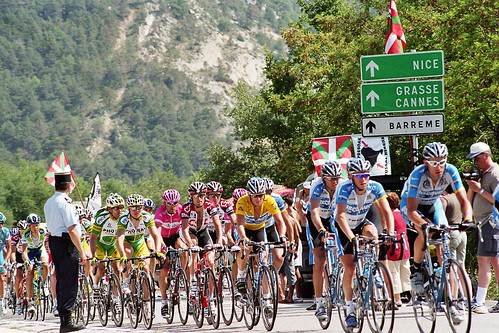

3 thoughts on “Tour de France – Quotes, facts and stats”